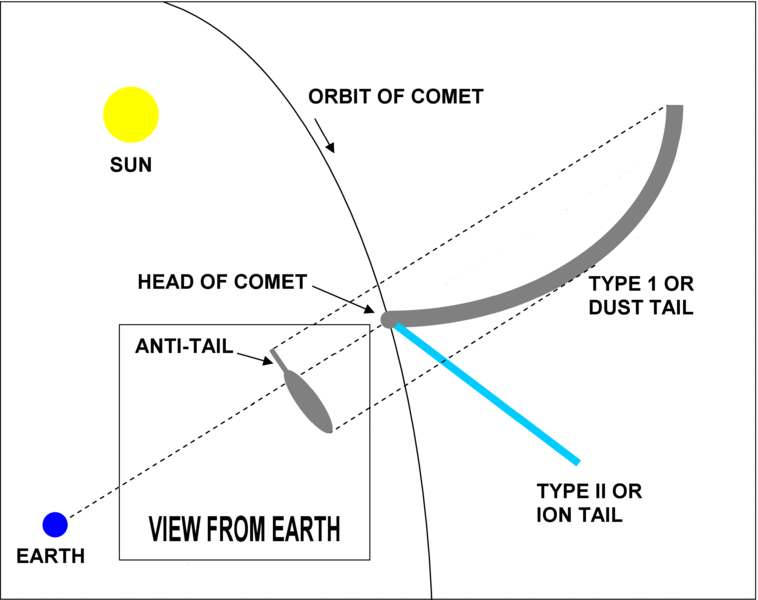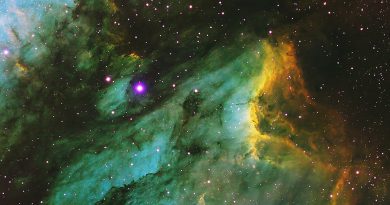Comet C/2022 E3 (ZTF) Imagers
The headlines at the start of the year spoke of a “green comet” or “Neanderthal comet” that last sailed by the Earth 50,000 years ago and was gazed at by awed cave dwellers. In truth, we don’t know the exact timing of that ancient fly-by and if any Paleolithic people noted it.
What we do know is that C/2022 E3 (ZTF) is a long-period or non-periodic (“C/”) comet first sighted last year (“2022”) in early March (“E”) as the 3rd (“3”) comet discovered in the first half of that month. The facility that found the object was the Zwicky Transient Facility (“ZTF”). The green glow is not uncommon in comets: it is due to the presence of diatomic carbon and cyanogen shed by the comet and fluorescing from solar radiation.
The closest approach to Earth (0.28 astronomical units) was the evening of February 1st Universal Time when it was high in the northern sky near the pole as a magnitude 4.5 fuzzy object. Visually, with the Moon 84% full, the comet was washed out with just the triangular-shaped coma visible and no sweeping tail like in the long-exposure photographs.
If you’ve been studying images of the comet you’ll note how cometary features, on images a few days apart, can show dramatic change. This included an ion tail “disconnection” event and an antitail as it neared Earth — caused by particles shed by the comet becoming visible as the plane of Earth’s orbit intersected the plane of the comet’s orbit.
Brian Paczkowski
Taking full advantage of the wide field afforded by the Tele Vue-76 APO (mobile site) refractor, Brian was able to capture much of the incredibly long ion tail of the comet using a QHY 268M astro camera. The green ionization around the comet is very prominent and the dust tail is short and trails behind the coma.

On January 21st Brian captured an ion tail disconnection event (the thin vertical tail) using the same Tele Vue-76 APO setup as the color image above. To create the video below, 23 Luminance frames of 2-minute exposure through a luminance filter were star-aligned using PixInsight. The images were then exported into Photoshop where the video was created. Numerous satellite trails had to be removed in order to get the final “clean” video presented here.
Michael Stark
From northern California, Michael used our Tele Vue-NP101is APO refractor (mobile site) and a full-frame DSLR camera to capture the long tail of the comet that overlapped the blue ion tail, the green glow around the coma, and the stubby antitail appearing to the right of the coma. To gather all this detail required an hour-long exposure taken one minute at a time.

The comet made a nice pass by Mars in the second week after the closest approach to Earth.

Chris Carlton
Chris used a Tele Vue-NP101 APO with NPR-1073 0.8x reducer (f/4.3) to create a fast imaging system for his hydrogen-alpha sensitive Canon 60Da camera. This image, taken a few days before the closest approach, shows a compact coma, a faint ion tail, and a dust tail. The Tele Vue-NP101 scope has been replaced by the Tele Vue-NP101is APO refractor (mobile site) in our product line.

Mike Broussard
Mike used a Tele Vue-85 APO (mobile site) with TRF-2008 0.8x Reducer/Flattener to create an f/5.6, 480mm, lens for his QHY294C-Pro color camera to image the comet a few days after the closest approach. Note the long ion tail going out of the frame. This was also the “first light image” for the camera. Mike told us about the conditions:
The bright moon was near the comet and made getting the dim ion tail very hard. Luckily, I was able to fix most of that issue with a good “flat” calibration frame. There were still minor issues with the right side part of the frame on one set of sub-images where the tail is and I actually had to dim it down a bit.

Alexander Surkov
Alexander’s image of Comet ZTF was made with the Tele Vue-NP101is APO refractor (mobile site) and a total exposure time of just over an hour with a ZWO ASI2600MC Pro color camera. This is a well-balanced image showing a prominent antitail extending from the green fluorescence around the coma. The lengthy ion tail is aligned with the dust tail against a star-studded, uniform, dark background.

We hope you enjoyed the images as this is the last we’ll see of this comet: this passage through the Solar System has perturbed the orbit enough to cast it out of the system or at least on a return orbit that will take millions of years.
Did you observe, sketch, or image with Tele Vue gear? We’ll like your social media post on that if you tag it #televue and the gear used. Example:
#televue #tv85 #ethos comet #C2022E3
Do you want your Tele Vue images re-posted on Tele Vue Optics’ Social Media accounts? Use this hashtag for consideration:
Images of Comets Past
- Comet NEOWISE in the Northern Skies! blog post.
- Evolution of Comet Holmes’ 2007 Apparition blog post.






